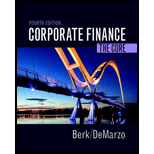
Corporate Finance: The Core (4th Edition) (Berk, DeMarzo & Harford, The Corporate Finance Series)
4th Edition
ISBN: 9780134202648
Author: Jonathan Berk, Peter DeMarzo
Publisher: PEARSON
expand_more
expand_more
format_list_bulleted
Question
Chapter 12, Problem 16P
Summary Introduction
To discuss: The comparison of the expected return using two methods.
Introduction:
Expected return refers to a return that the investors expect on a risky investment in the future.
Expert Solution & Answer
Want to see the full answer?
Check out a sample textbook solution
Students have asked these similar questions
Finance problem solve
Need answer for this.
Need asst. pls
Chapter 12 Solutions
Corporate Finance: The Core (4th Edition) (Berk, DeMarzo & Harford, The Corporate Finance Series)
Ch. 12.1 - According to the CAPM, we can determine the cost...Ch. 12.1 - What inputs do we need to estimate a firms equity...Ch. 12.2 - How do you determine the weight of a stock in the...Ch. 12.2 - Prob. 2CCCh. 12.2 - Prob. 3CCCh. 12.3 - How can you estimate a stocks beta from historical...Ch. 12.3 - How do we define a stocks alpha, and what is its...Ch. 12.4 - Why does the yield to maturity of a firms debt...Ch. 12.4 - Prob. 2CCCh. 12.5 - What data can we use to estimate the beta of a...
Ch. 12.5 - Prob. 2CCCh. 12.6 - Why might projects within the same firm have...Ch. 12.6 - Under what conditions can we evaluate a project...Ch. 12.7 - Prob. 1CCCh. 12.7 - Prob. 2CCCh. 12 - Prob. 1PCh. 12 - Suppose the market portfolio has an expected...Ch. 12 - Prob. 3PCh. 12 - Suppose all possible investment opportunities in...Ch. 12 - Using the data in Problem 4, suppose you are...Ch. 12 - Prob. 6PCh. 12 - Prob. 7PCh. 12 - Suppose that in place of the SP 500, you wanted to...Ch. 12 - Prob. 9PCh. 12 - You need to estimate the equity cost or capital...Ch. 12 - In mid-2012, Ralston Purina had AA-rated, 10-year...Ch. 12 - Prob. 15PCh. 12 - Prob. 16PCh. 12 - Prob. 17PCh. 12 - Your firm is planning to invest in an automated...Ch. 12 - Consider the setting of Problem 18. You decided to...Ch. 12 - Prob. 20PCh. 12 - In mid-2015, Cisco Systems had a market...Ch. 12 - Weston Enterprises is an all-equity firm with two...Ch. 12 - Prob. 24PCh. 12 - Your company operates a steel plant. On average,...Ch. 12 - Prob. 26PCh. 12 - You would like to estimate the weighted average...
Knowledge Booster
Similar questions
arrow_back_ios
SEE MORE QUESTIONS
arrow_forward_ios
Recommended textbooks for you
 Essentials of Business Analytics (MindTap Course ...StatisticsISBN:9781305627734Author:Jeffrey D. Camm, James J. Cochran, Michael J. Fry, Jeffrey W. Ohlmann, David R. AndersonPublisher:Cengage Learning
Essentials of Business Analytics (MindTap Course ...StatisticsISBN:9781305627734Author:Jeffrey D. Camm, James J. Cochran, Michael J. Fry, Jeffrey W. Ohlmann, David R. AndersonPublisher:Cengage Learning

Essentials of Business Analytics (MindTap Course ...
Statistics
ISBN:9781305627734
Author:Jeffrey D. Camm, James J. Cochran, Michael J. Fry, Jeffrey W. Ohlmann, David R. Anderson
Publisher:Cengage Learning